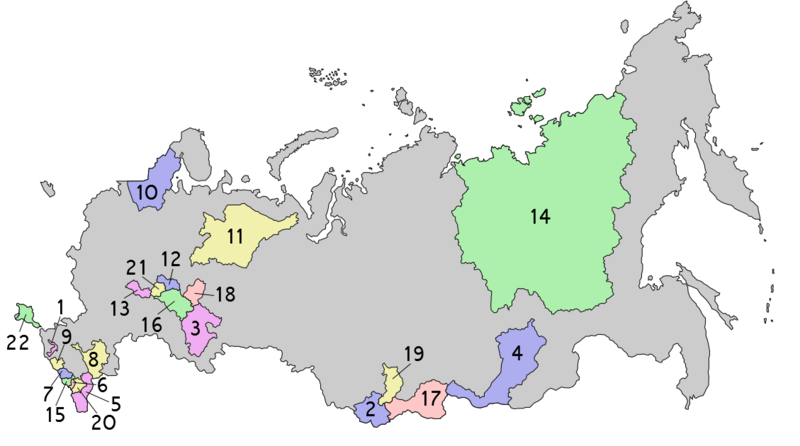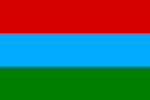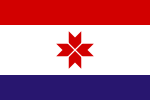Republics of Russia
According to its constitution, the Russian Federation is divided into 85 federal subjects, 24 of which are republics (Russian: республика, romanized: respublika; plural: республики, respubliki). Republics are administrative divisions originally created as nation states to represent areas of non-Russian ethnicity. The indigenous ethnic group that gives its name to the republic is called titular nationality. However, due to centuries of Russian migration, each nationality is not necessarily the majority of the population of a republic. If you do not consider the Republic of Crimea and the federal city Sevastopol as part of Russia (annexed in 2014) and Donetsk and Lugansk federal subjects are 83.
Formed in the early 20th century by Lenin and the Bolsheviks after the collapse of the Russian Empire in 1917, the republics were intended to be nominally independent regions of Soviet Russia with the right of self-determination. Lenin's conciliatory stance towards Russian minorities made them allies in the Russian Civil War and with the creation of the Soviet Union in 1922 the regions became Autonomous Soviet Socialist Republics (RSSAs), a third order of autonomy, subordinate to a union republic. Although officially autonomous, the RSSA was in practice hyper-centralized and largely under the control of the central leadership of the Soviet Union. Throughout its history, the RSSA experienced various periods of Russification and cultural revival depending on who ran the country. The 1980s saw an increase in the demand for autonomy as the Soviet Union began large-scale reforms of its centralized system. In 1990 the ASSR declared their sovereignty and renounced their status as autonomous republics.
The Soviet Union collapsed in 1991 and Russia became independent. The current republics were established with the signing of the Federation Treaty in 1992, which granted them substantial rights and autonomy. The republics differ from other subjects in that they have more powers delegated to them. The republics have their own constitutions, official languages, and national anthems. Due to this, Russia is an asymmetric federation since the other subjects do not have these rights. Powers vary between republics and largely depends on their economic power. Through the signing of bilateral treaties with the federal government, the republics had broad authority over their economies, domestic policies, and even foreign relations in the 1990s. However, at the turn of the century, Vladimir Putin's centralization reforms they constantly eradicated all the autonomy that the republics had with the exception of Chechnya. Bilateral agreements were abolished and in practice all power rests with the federal government. With the termination of the final bilateral treaty in 2017, some commentators expressed that Russia ceased to be a federation.
Constitutional condition
Republics differ from other administrative units in that they have their own constitution and have the right to establish their own official language (Article 68 of the Constitution of the Russian Federation).
Other administrative units, such as krais (territories) and oblasts (regions), do not have these possibilities, however, republics do not have governmental sovereignty (according to article 3 of the Constitution).
Territories annexed to Ukraine
The Republic of Crimea is currently claimed by Ukraine.
- The Republic of Crimea was proclaimed on 11 March 2014, covering the Ukrainian territories of the Autonomous Republic of Crimea and the special city of Sebastopol. On 17 March 2014, one day after the referendum on the political status of Crimea, the Republic was officially established as an independent State, recognized only by the Russian Federation, becoming a partially recognized country, and requested its annexation to the Republic within a few minutes of achieving independence. The next day, 18 March, following the signing of the Crimean and Sevastopol annexation agreements to the Russian Federation, he officially became a federal subject, a republic, under Russian sovereignty. The city of Sebastopol joined Russia with the status of a federal city.
- The Republic of Crimea is not recognized by Ukraine, the United States, the European Union and the largest part of the international community, since its secession and incorporation into Russia was carried out without respecting Ukrainian legislation and is therefore considered to be "illegal", so the territory is legally still the Autonomous Republic of Crimea. The Supreme Rada of Ukraine approved on 15 April, with 228 votes in favor of a total of 450, a law that defines as "territories under temporary occupation" the Republic of Crimea and the city of Sebastopol. The regulations indicated that these territories are "inalienable part" of Ukraine and are subject to Ukrainian laws, but it points out that Russia must compensate the economic damage of the "annexation" and respond to any human rights violations occurring on the peninsula.
On February 24, 2022, Russia invaded Ukraine, seizing large swathes of southern and eastern Ukraine. As early as March, the leaders of the internationally unrecognized but de facto independent Luhansk People's Republic and Donetsk People's Republic expressed their desire to join Russia, originally once Russia had captured all of their claimed territory. However, in September 2022, after a series of victorious Ukrainian offensives[which?] recaptured some previously lost territory in the east, Russia and the unrecognized republics rushed a series of referendums on annexation to Russia. The referendum results stated that an overwhelming majority supported the annexation. On 30 September 2022, Putin formally announced the annexation of the two republics and the Kherson and Zaporizhia oblasts. However, the European Union and the countries that form the G7 rejected these referendums considering them illegal. United Nations Secretary General António Guterres condemned the annexations as a violation of the United Nations Charter. According to Volodimir Zelensky, respecting Ukraine's international borders is one of the non-negotiable conditions for peace with Russia.
Contenido relacionado
United States Constitution
Commonwealth of Independent States
Indian politics
























